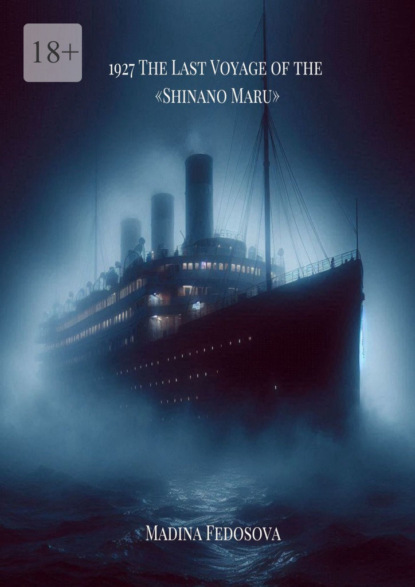- -
- 100%
- +

© Madina Fedosova, 2025
ISBN 978-5-0067-6013-4
Created with Ridero smart publishing system
Author’s Foreword:
Dear Reader,
Before you is a work of fiction, inspired by real events but not claiming to be a documentary. The story of the sinking of the Shinano-maru in 1927 is indeed shrouded in mystery – the official reports are contradictory, the testimonies of the survivors differ, and some documents have vanished from the archives.
I have based this story on the facts I was able to reconstruct:
Date of the disaster: March 15, 1927, Pacific Ocean.
Official cause: boiler explosion, though Mitsubishi’s experts denied it.
Oddities: entries in the ship’s log about “strange noises” from the hold, a mysterious note from the captain.
But beyond that – the story is fictional.
My aim wasn’t to recreate the exact chronology of events. Instead, I tried to bring the era to life:
Japan in the 1920s – a nation at a crossroads between tradition and modernization.
People – not just “victims of the disaster,” but characters with their own fears, secrets, and hopes.
The mystery – what really happened on board?
If you’re seeking a documentary investigation, this book is not for you. But if you want to feel the atmosphere of that fateful voyage, to hear the whispers of the steel bulkheads, and to try to solve a puzzle that the sea has kept for almost a century – welcome aboard the Shinano-maru.
Sincerely,
Madina
P.S. Perhaps the truth lies somewhere in the middle – between the official reports and the legends that sailors tell in the port taverns. Or perhaps it’s better not to know it at all…
Prologue
Pacific Ocean, March 15, 1927
Captain Masato Shinagawa gripped the helm of the Shinano-maru with bloodied fingers, feeling the intricate pattern of the brass handle pressing into his skin, leaving impressions that resembled cryptic runes. His palms, accustomed to all manner of storms over thirty years of service, were now trembling – not from fatigue, but from what had transpired in the last forty minutes. The air, thick with the ruby-red glow of the emergency lamps, was like a rich broth: gunpowder smoke mixed with the coppery scent of blood and something else – a cloying, putrid sweetness, reminiscent of a can of preserved food forgotten in the tropical sun.
At his feet, in a pose that no textbook on anatomy could describe, lay the second engineer, Yamada. His right hand, covered in strange blisters, resembling burns from boiling oil, still clutched a 32-millimeter King Dick wrench – the very one he had brought from England in 1912. The captain noticed how the death grip had twisted the engineer’s fingers, turning the knuckles white as though it were a frosty morning. The bullet hole in his right temple looked unnaturally black – not merely dark, but absorbing light, like a tiny hole in reality itself.
From the depths of the ship came a sound that sent a chill down even Shinagawa’s spine, a man who had witnessed both the tsunami at Tsushima and the uprising in Shanghai. It was neither the screech of metal against rocks, nor the roar of collapsing bulkheads. Rather… imagine someone drawing a bow across taut intestines, while simultaneously slapping wet meat against a sheet of tin. And beneath that – a rhythmic gurgling, as though enormous lungs were filling with water somewhere in hold number three, directly beneath their feet.
“They… they’re moving…” – the young sailor Takeshi, that eternal scamp who only a week earlier had been laughing at the bosun, now pressed himself against the bulkhead, his voice cracking into a squeak. The captain noticed how the boy’s eyes had become unnaturally wide, the pupils dilating to the size of coins, reflecting the trembling light of the lamps. “Captain, for God’s sake, they’re BREATHING!”
Shinagawa slowly ran his tongue over his cracked lips. The taste was familiar – salt, gunpowder, fear. That was precisely the way his nightmares had smelled after that voyage on the Takamaru in 1918. His gaze fell upon the Hamilton chronometer – a gift from an American captain after the rescue of the “SS Eastern Light.” The hands read 02:17. An eternity until dawn. An eternity and a half until the nearest shore. And until the moment when “it” reached the upper deck… perhaps only minutes.
“Seal the hold,” – his voice sounded so calm that he surprised even himself. As if it wasn’t him speaking, but someone else, using his vocal cords. “And… prepare the lifeboats. By order of priority.”
“But the women… the children…” – helmsman Okazaki turned, and Shinagawa saw in his eyes the same animal terror he’d seen in the engineer’s eyes a second before the man put the revolver to his temple. “We can’t…”
At that moment, the Shinano-maru shuddered, as if a giant hand had seized its keel and yanked it downwards. Somewhere below, in the bowels of the ship, something groaned – a sound that was reminiscent of both a child’s weeping and the creaking of rusty hinges. The captain felt a chill run down his spine.
He knew they had made a fatal mistake. They should never have loaded those twelve crates, marked with “Osaka Industries,” onto the ship. They should never have trusted those who whispered of “new weaponry” in oak-paneled offices, sipping whiskey and studying maps marked with red crosses along the 37th parallel. Especially after what had happened with the Takamaru.
And now, the cargo was awakening. And it was hungry.
Part One Japan, 1927
A Nation Torn Asunder
Chapter 1
Whispers of Change Tokyo, April 1927
Tokyo, March 1927
The morning mist clung to the ruins of Asakusa, as if ashamed of what would be revealed when it dispersed. Fourteen-year-old Takeshi, clutching a bundle of yesterday’s rice (a gift from the proprietress of the tea house where he scrubbed the floors), made his way past the brand-new Tokyo Jazz Club. From the open windows poured “Rhapsody in Blue,” mixing with the cries of vendors: “Fresh copy of the Yomiuri! Mitsui Bank suspends payments!”
A girl in a Chanel dress, which cost 200 yen – the price of 50 sacks of rice – caught her reflection in the shop window, where mannequins in tuxedos stood alongside traditional haori. Her fingers, in lace gloves, adjusted her garter as a gold hairpin slipped from her fashionable “à la garçonne” haircut. “Charming, isn’t it?” she whispered in English to her companion, an American diplomat. The same falseness rang in her voice as in the gold bracelet (the gold plating already flaking at the bend of the wrist). Three steps away, the blind veteran Ito, who had lost his sight at Port Arthur, plucked the strings of his shamisen. The instrument, a survivor of the war, was now falling apart, just like the old man himself. Before him lay: a tin mug (formerly a can of American corned beef), three sen (enough for barely a cup of the swill sold as “tea” at the port), and a yellowed photograph of his company (1904). “Haru no Umi” (“Spring Sea”) trembled in his fingers – one string was missing (sold last month for a bowl of soup). Passersby glanced at him: The young fashionista scoffed: “How archaic!” A bank clerk slowed his pace, but remembered that today he had to pay for a new suit. Only an old woman in a worn kimono stopped and whispered: “Ito-san… you played this before the attack, didn’t you?” The girl in Chanel, meanwhile, was laughing at the American’s joke: “Oh, these quaint Japanese musicians! So… authentic!” And the shamisen continued to play. The last string hummed like a signal wire on the front line, warning that all of them – the fashionista, the veteran, and even the smug American – were already standing on the edge of a new disaster. But who in 1927 could hear that call?
Rain washed the golden dust from the windows of Matsuzakaya, where mannequins in European suits stood next to kimonos made of cheap viscose silk – the new word in Japanese textile industry. In a puddle at the feet of the girl in the Chanel dress floated a wrapper from American Wrigley’s chewing gum, which she had just thrown away, wrinkling her nose: “Too sweet.” “Ghastly, isn’t it?” she said in English to her companion, American banker Johnson, adjusting her garter. “These beggars are everywhere.” The man chuckled, pulling out a cigarette case engraved with “Made in Detroit”: “But now you have a real civilization.”
At the Burnt-Out Sensō-ji Temple
“Hey, boy!” Takeshi was called out to by old Ryota, who was sitting on a broken piece of a column with a barely visible emblem of the shogunate. In his hands, he held a tea bowl, glued together with rice paste – there was no money for gold kintsugi lacquer.
“Do you know why modern Japan is called a ‘woman in a European dress’? ” he asked, adjusting his broken glasses, which were taped with paper.
Takeshi shook his head, feeling the scent of roasted chestnuts and something bitter – possibly medicine for tuberculosis, which was sold in the alley.
“Because she is beautiful from afar,” the old man whispered, “but if you get closer, you can see that the dress doesn’t fit, and beneath it are all the same old scars.”
He handed the boy a copy of Chūō Kōron, where, next to a report on the growth of car imports (300% per year), nestled a tiny note: “Cases of child trafficking have been recorded in Fukushima Prefecture—5 yen for a healthy boy.”
Takeshi’s thoughts: “5 yen… That’s how much a ticket costs for the new American film Wings, or a portion of ice cream at the Lyon cafe.” He remembered how the other day he saw a woman in a worn kimono leaving a child at the doors of the Mitsui orphanage. The sign promised “European upbringing and three meals a day.”
“When a country changes its skin, it itches at first, then it hurts, and then – there’s only a scar left.”
(From the diary of a schoolteacher, 1926)
Rain intensified, washing away the remnants of yesterday’s celebration of the opening of the new bank from the sidewalk. Takeshi hid the newspaper under his clothes – next to a photograph of his father, who died during the construction of the South Manchurian Railway. “Ryota-san,” the boy suddenly asked, looking at the veteran, “why does he play ‘Haru no Umi’? ” The old man retrieved a small bottle of cheap sake (1.5 yen, with added rice alcohol) from under a rush mat: “In 1905, this melody was played before the attack on Port Arthur. Now it sounds like a warning.”
A clipping about Lindbergh’s flight across the Atlantic fell out of his tattered haori. Scrawled in clumsy handwriting on the margins were the words: “When eagles fly too high, they forget who feeds their chicks.”
Scene in the Tea House “Sekisen”
The proprietress, O-Tsuru, a former geisha who now served the new masters of life, was cleaning an expensive Chinese vase.
“In 1905,” she said, wiping the dust from a photograph of Emperor Meiji, “when our sailors defeated the Russians, we drank sake from the same vessels. Now…” she pointed to an American can opener lying next to the ceremonial teapot, “they use them to store Swift & Company corned beef.”
Her hands, which had once been able to extract sounds from the koto worthy of the imperial court, now trembled as she poured cheap tea for banker Kawasaki.
“O-Tsuru-san,” he chuckled, grabbing her wrist, “soon you’ll be serving ‘Coca-Cola’ with sandwiches!”
“Perhaps,” she smiled, hiding her eyes. “But for now, allow me to offer you ‘Sencha’ – the last tea from the Uji plantations. Like in the good old days.”
When the banker left, she picked up the cup he had touched with his lips and examined it for long seconds. Then – with a sharp movement – she smashed it on the stone floor.
“It is better to lose the porcelain than to forget oneself,” she whispered, gathering the shards. “But the shards still cut.”
Dialogue at the Docks
Tokyo, Tsukiji Docks. March 16, 1927
The midday sun, like molten honey, flowed down the steel hulls of the ships. Takeshi, squatting down, examined an unusual cargo – a coffin made of cherry wood with a bronze plaque: “The Remains of Mr. Edward Johnson. San Francisco. 1878—1927”. The lacquer gleamed unnaturally brightly for such cargo.
“Kobayashi-ji-san,” the boy whispered, “why do they even make coffins like works of art?”
The old docker, adjusting his broken glasses, answered thoughtfully:
“You see, Takeshi-kun, Americans believe that even death should be packaged as an expensive gift. In the East, we place only a modest branch of sakura in the coffin, but they – entire fortunes.”
His fingers trembled when the lid unexpectedly opened, revealing the white cuff of a shirt with the initials “EJ.” On the deceased’s wrist, a “Rolex Oyster” watch – the first waterproof watch in the world, released only a year ago.
“Mother of Buddha…” Kobayashi blurted out. His experienced eyes immediately noted the discrepancy: the watch showed 9:17, although the sun was high.
The wind carried the scent of rotting fish and gasoline. A brightly painted boat bobbed on the water – advertising the new “Ginza Palace” cinema, with a poster of Lang’s “Metropolis.” The robot Maria’s face, half erased by the waves, now resembled a Noh mask.
“Hey, boy!” shouted an American sailor from the “SS Silverstar,” throwing Takeshi a piece of chewing gum. “Here’s a taste of civilization!”
The gum landed in a puddle with an oily film. Kobayashi hunched over: “In 1905, we sank Russian ships. Now we’re catching their gum…”
From the diary of teacher Suzuki (1926): “When a foreign culture comes as a commodity, and not as a guest, it leaves behind not mutual understanding, but only empty chewing gum wrappers and uncomfortable questions.”
Suddenly, a click sounded from the coffin – the watch mechanism had started itself. The hands spun backwards.
Tokyo, Asakusa district. March 16, 1927. 5:23 AM.
Dawn was just beginning to blur the night shadows, coloring the sky in pale gray tones, when Takeshi, wrapped in a worn-out haori with a faded family crest, made his way through the deserted streets. The air was filled with a complex range of smells – burnt wood from recently rebuilt houses, damp earth after the night rain, and the faint, salty aroma of the Sumida River, mixed with soot from the coal stoves. This peculiar “Tokyo perfume” had become familiar after the Great Earthquake of 1923, when the city, like a phoenix, began to rise from the ashes.
At the base of a ruined gas lamp, whose rusty foundation still bore traces of that terrible fire, sat the blind veteran Ito. His shamisen – once a beautiful instrument made of red sandalwood with mother-of-pearl inlays in the shape of flowering cherry blossoms – now lay on his lap like a wounded crane. Three strings had long disappeared, and only one, the thickest, made of the highest quality silk (the kind used by court musicians of the Edo period), remained, reminiscent of past grandeur.
“Ito-san…” the boy called cautiously, noticing the morning breeze ruffling the old man’s gray hair. His voice sounded particularly loud in the pre-dawn silence, broken only by the rare cries of street vendors beginning their day.
The old man slowly raised his face, furrowed with deep wrinkles and scars left by shrapnel at Port Arthur. His clouded eyes, deprived of sight from that fateful day in 1905 when Russian shrapnel blinded him forever, seemed to see something beyond this world.
“Cold, boy?” he laughed hoarsely, and his breath turned into a small cloud in the cold air. “When you’re seventy, cold becomes your second name. But hunger… Hunger is a special torturer. It doesn’t let you forget that you’re still alive.”
From the nearby eatery “Morning Carp,” where they prepared the first breakfast for dockworkers and rickshaw drivers, came the rich aroma of miso soup with tofu and dried mackerel. The proprietress, a woman in her fifties with hands covered in burns from constant contact with boiling water, appeared in the doorway, holding an old faience bowl with steaming broth.
“Last time, old man,” she said, and in her voice there was not so much rudeness as tired resignation. “Tomorrow – either ten sen, or your instrument. I have a family myself, you understand.”
Ito slowly ran his trembling fingers over the only remaining string. The sound was shaky, but surprisingly pure – like the last cry of a dying era. Then, with a sharp movement, as if cutting off his own finger, he removed this string – the very one that had once played before General Nogi himself during the siege of Port Arthur.
“Music dies last…” he whispered, holding out the precious silk thread. “But it is resurrected first, when all other voices have fallen silent.”
Takeshi saw how the old man’s hands trembled as he accepted the bowl. The veteran had not eaten, judging by his hollow cheeks and protruding cheekbones, for several days. His dirty kimono, with the barely discernible crest of a once-noble samurai family, hung on him like on a hanger.
At that moment, the sound of a new “TGE” (Tokyo Gas Electric) bus, which had just begun to run in the area, came from around the corner. Its roar drowned out the last notes of the dying music, and its exhaust fumes mixed with the aroma of morning broth, creating a strange metaphor for the new era.
Ginza Street. 1:40 PM.
Takeshi made his way through the bustling street, where the smell of roasted chestnuts mingled with the acrid smoke from factory chimneys. Signs flashed overhead: “Café Lyon – Real French Coffee!”, “Matsuya Store – Singer Sewing Machines on Installment!”, and next to them – a modest sign for an old kimono shop, almost lost among the bright neon letters.
Two students stood by the window of the Matsuzakaya department store, where mannequins in tuxedos stood alongside traditional haori. The first – in a brand-new suit from “Tailor Toyo,” with a tie pinned with an expensive anchor-shaped pin (a gift from his shipowner uncle) – nervously tapped his lacquered shoes on the sidewalk. The second – in a worn but impeccably clean gakuran, with a battered volume of Nietzsche under his arm – gazed thoughtfully at the plumes of smoke rising over the industrial district.
“Have you seen the new Ford automobiles at the parliament building?” exclaimed the first, excitedly, adjusting his pince-nez. “The Minister of Trade himself stepped out of one yesterday! This is progress! Soon we’ll have wide avenues like in New York!”
The second student turned slowly. His fingers squeezed the book so tightly that his knuckles turned white. He took a deep breath of the smoke-laden air and smiled bitterly:
“They call this progress, but why does it smell like burning?” He pointed to the factory chimneys in the distance, whose black plumes stretched across the sky like clouds. “Yesterday at the Suzuki school, three children fainted from the smog. The teacher opened a window – and within five minutes the class was coughing as if they were in a gas attack.”
The first student fidgeted, his fingers drumming nervously on the lid of his Omega pocket watch:
“This is a temporary cost! In ten years, when all the factories switch to new standards…”
“In ten years,” the second interrupted, turning sharply so the sun glinted off his glasses, “we’ll be breathing through gauze masks and remembering the scent of blooming cherry blossoms in Ueno Park. Remembering the smell of rain on the cedar boards of an old temple. And our children will ask, ‘Father, what is ‘clean air’?’”
Takeshi, passing by, slowed his pace. His bare feet felt the sticky mud on the sidewalk – a mixture of rainwater, machine oil, and something else he couldn’t identify. In the pocket of his worn-out jinbei lay the same silk string he had picked up after Ito left. His fingers squeezed it, and suddenly the blind veteran’s words flashed in his memory: “When the last string disappears, the music doesn’t die – it just gets quieter, so that only those who truly listen can hear it.”
Somewhere in the distance, a siren wailed – a new, American-made fire engine. A street vendor selling “Tokui-style ramen” (which was actually just noodles with cheap broth) shouted loudly, shooing away the flies. And from the open doors of the “Palermo” cafe, the sound of jazz drifted out – the new hit, “Tokyo Shuffle,” which everyone was now humming.
The student in the gakuran suddenly turned sharply to his companion: “Do you know what they’re selling at the pharmacy on the corner now? A cure for ‘Western dizziness’ – for those who are running too fast after progress and losing themselves.”
His friend blushed and turned away, looking at the display window, where, among other goods, a brand-new radio receiver was proudly displayed with a sign that read “The Latest Fashion Scream from Europe!”
Takeshi sighed deeply and walked on, towards the docks. The sweetish smell of burnt sugar from the nearest confectionery lingered in the air, but it was overridden by the acrid smoke of a steamboat that was just passing on the Sumida River. Somewhere between these aromas, between the old and the new, between the shamisen string and the roar of automobile engines, something important was being lost. Something he couldn’t yet name.
Chapter 2
Whispers of Old Tokyo
Nihonbashi District, March 17, 1927. 7:15 AM
The golden dawn, seeping through the soot-stained glass of Takeshi’s tiny cubicle, painted whimsical patterns on the floor, resembling either a map of new Tokyo streets or cracks on old porcelain. Each ray, passing through the uneven glass, refracted in a unique way, illuminating dust motes dancing in the air – tiny witnesses to yesterday’s cleaning.
The air was filled with a complex range of smells:
The sweetish smoke of coal braziers from the “Morning Tea House” across the street, where they were preparing the first breakfasts for workers
The sharp aroma of freshly grilled mackerel – the fisherman Ueda had already laid out his wares on the stall, sprinkling them with coarse sea salt
A faint metallic tang – perhaps from the new water tower around the corner, built just a month ago according to American blueprints
The tart smell of freshly brewed tea, mingling with the aroma of roasted chestnuts from the street vendor
Takeshi stretched, and his bare feet touched the cool tatami, woven from old reeds – exactly the same kind that once grew along the canals of Edo a hundred years ago. His toes automatically felt for the familiar unevenness of the weave – here, in the right corner, was a small hole that he had been meaning to mend for a long time.
His haori, once dark blue (the color of the night sky over Edo, as his father used to say), had now faded to a gray-blue hue, but the family crest – three rice ears, symbolizing the prosperity of his ancestors – could still be discerned on the back, if you looked closely. A neat patch was visible on the left elbow – the work of the proprietress O-Fuji, done a month ago in exchange for helping unload a tea shipment.
The “Shōfūan” Tea Shop
The bell above the door rang especially sharply as the first customer crossed the threshold. “One sencha tea, please!” came the familiar voice of Mr. Tanaka, the kimono shop owner from the neighboring alley. His worn, but impeccably clean kimono made of inexpensive cotton with a faded wave pattern betrayed a thrifty owner.
O-Fuji, without looking up from the brazier, nodded: “Right away, Mr. Tanaka! Just took it out of the oven – can you smell that aroma?” She deftly flipped the rice cakes with a bamboo spatula, leaving appetizing scorch marks on them. Her hands, covered with a web of minor burns – living evidence of thirty years at the brazier – moved with honed precision.
“And for you, as usual – with ume paste?” the proprietress specified, already reaching for the clay pot with the salted plums.
Mr. Tanaka frowned unhappily: “No ume today, O-Fuji-san. My daughter gave me a lecture about my blood pressure for a whole hour yesterday… She says modern doctors strictly forbid it.”






